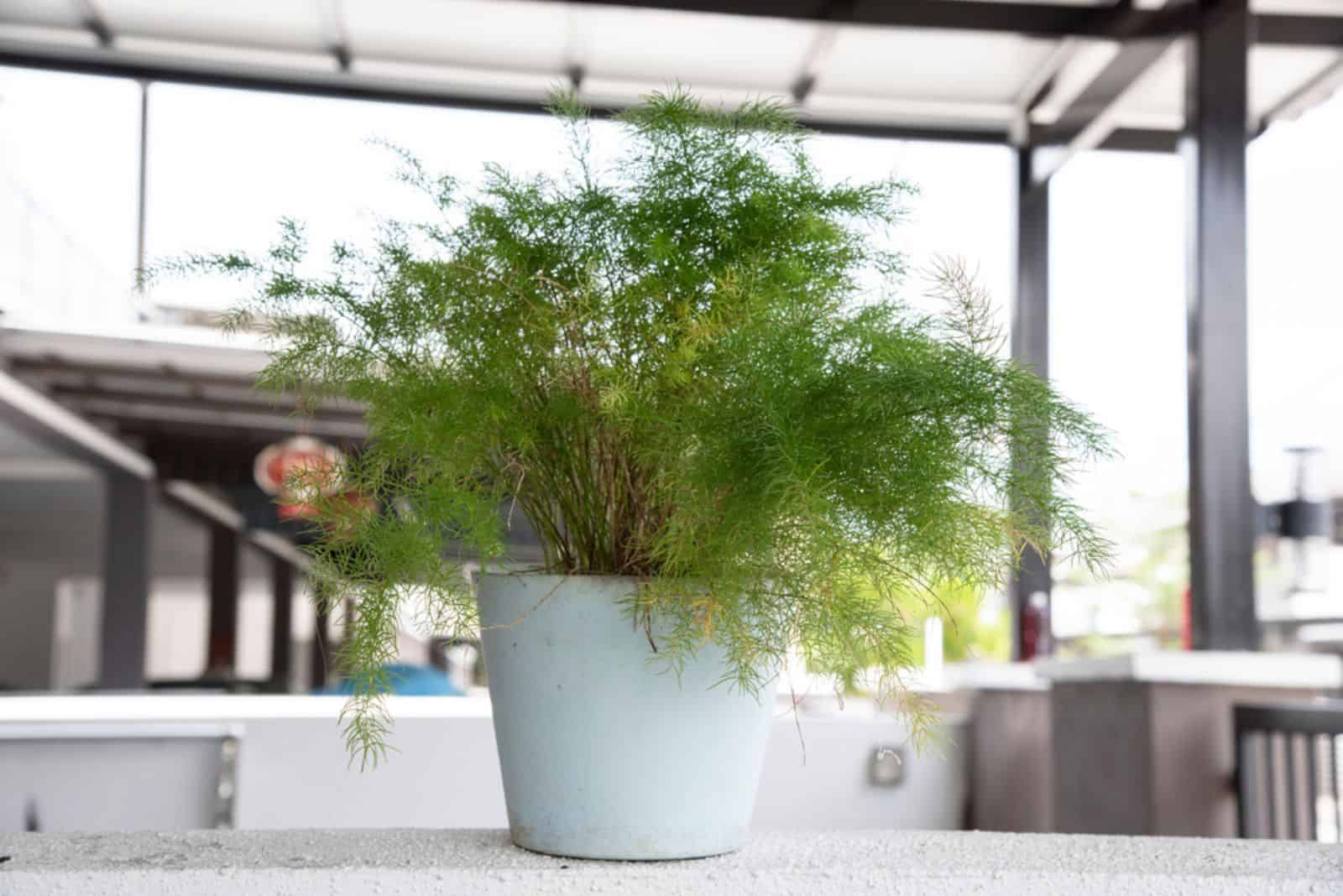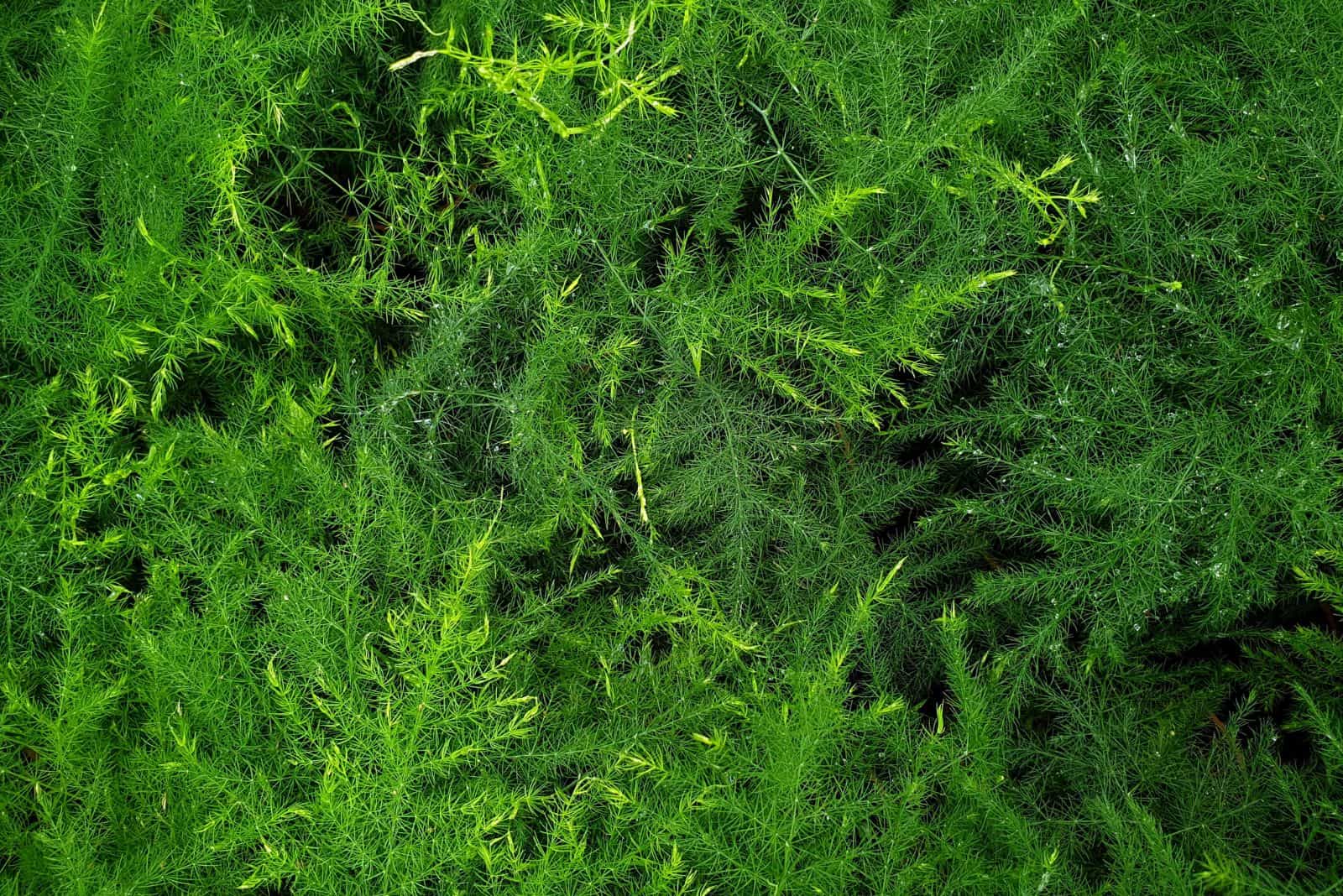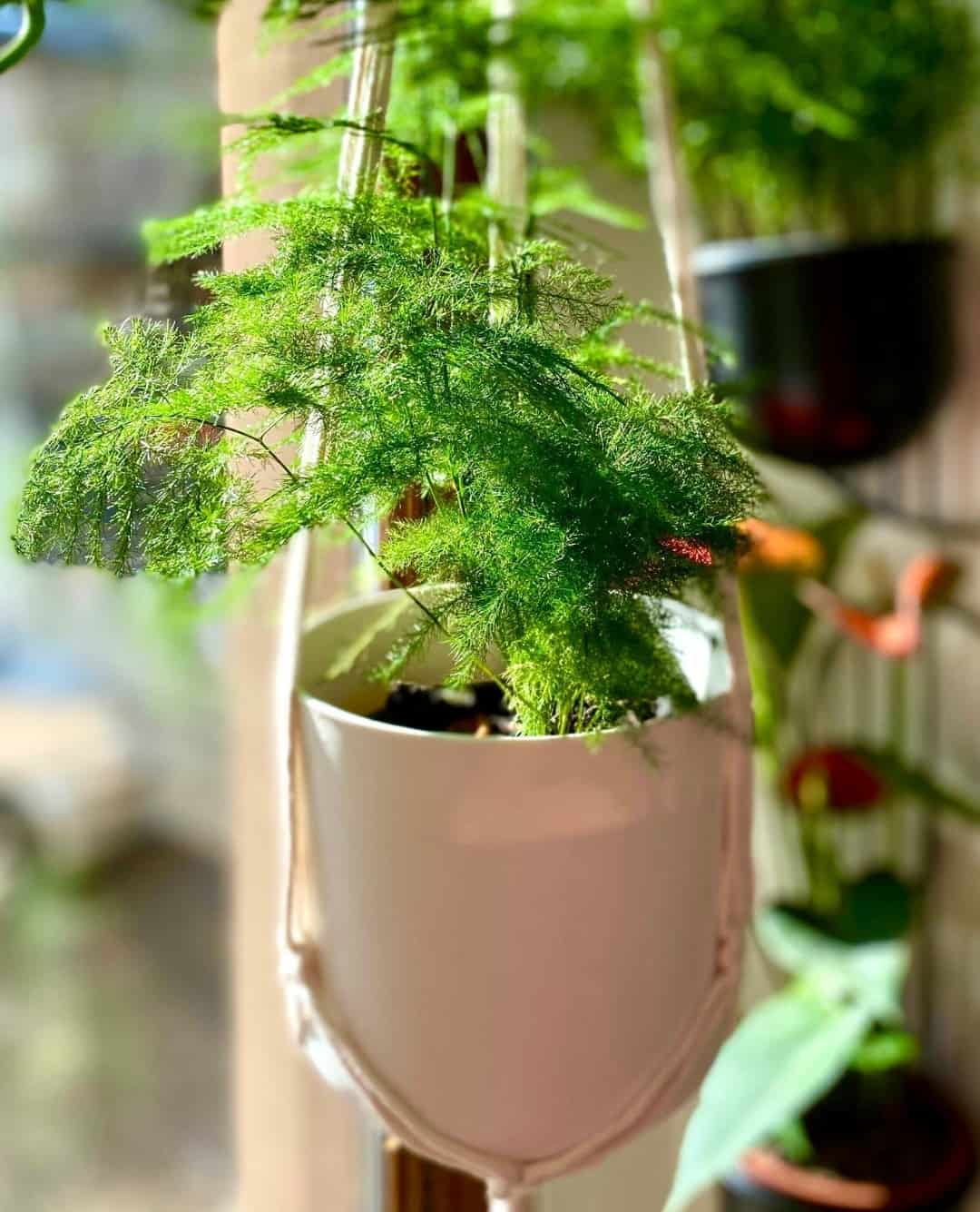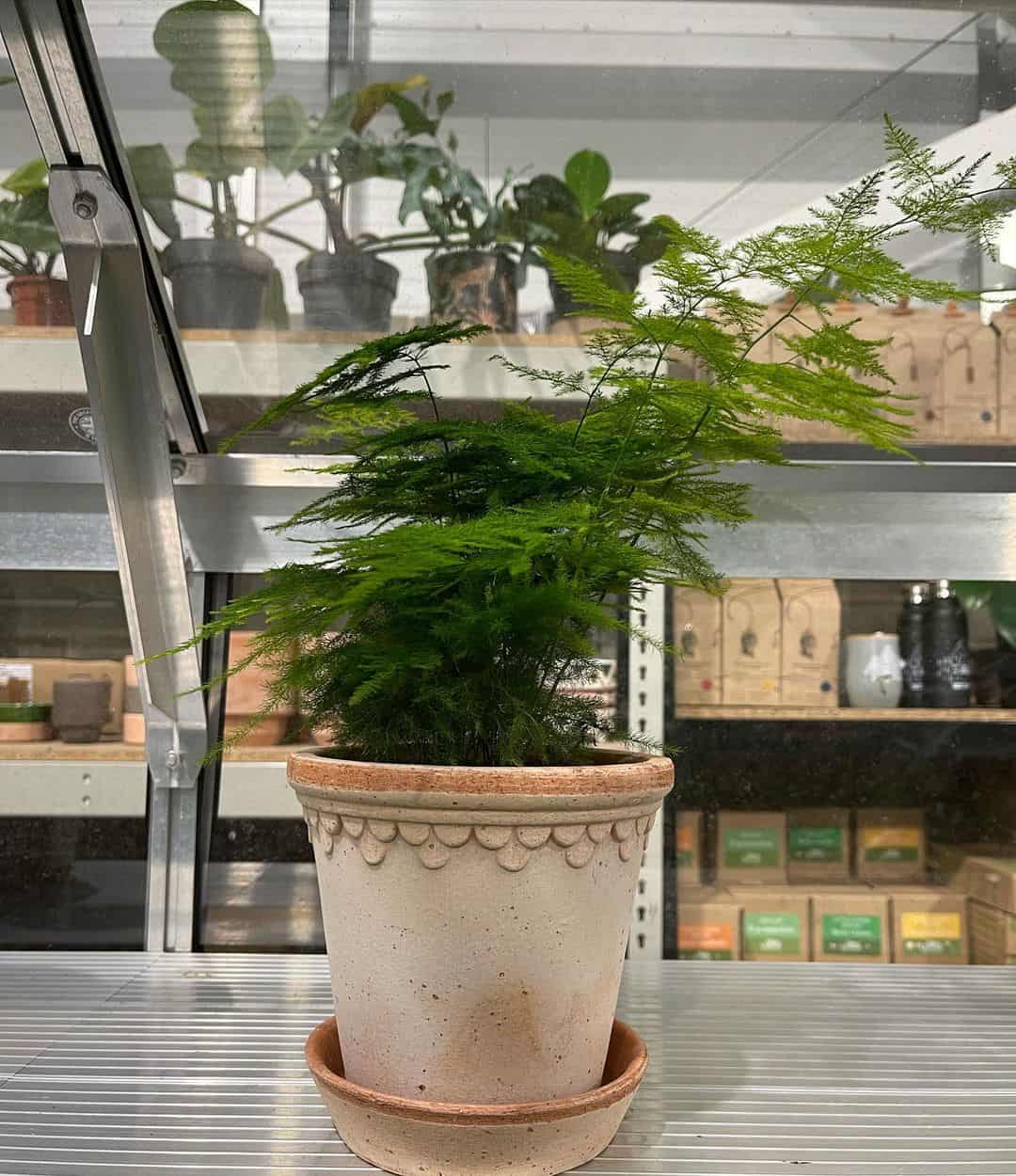The Plumosa Fern is a funny-looking type of fern that can also be grown as a houseplant. With its long and thin stems, along with soft and fluffy foliage, this fern definitely stands out!
It looks so fragile and eccentric!
Surprisingly, this plant is relatively easy to take care of and it can tolerate different growing conditions. Even though they belong to the Asparagaceae family, this plant is not considered to be a true fern.
If you want to learn more about the unique Asparagus Plumosa fern, keep reading!
What Is The Plumosa Fern?
The Plumosa fern is truly a funky fern that you should add to your plant collection just for fun. Botanically known as Asparagus plumosus (“plumosus” meaning plumed), and Asparagus setaceus (“setaceus” meaning hairy), this Asparagus fern is a type of perennial climbing plant native to southern Africa.
In addition to its botanical names, this fern has other common names such as the Lace fern, the Climbing Asparagus fern, or the Asparagus sprengeri.
It produces plume-like, feathery foliage that gives the plant a soft appearance. These fern leaves are also called cladode. These plant components that resemble leaves are actually flattened stems. So, the plant’s base produces a number of green stems, each of which eventually turns into a soft frond. Asparagus ferns cannot perform photosynthesis without cladodes.
The stems grow tiny, pointy, almost undetectable spines as they get older. These spines should be dealt with special care if you are using them for flower arrangements.
What makes them different from true ferns is that this fake fern can actually produce flowers — the lovely Plumosa fern produces tiny white flowers that look absolutely magnificent!
Once they are done with flowering, they produce red berries that contain the seeds used to grow more Plumosas.
They are fast-growing plants that can grow up to 20 feet long if left unpruned. They are even considered invasive in regions with warm climates. However, you won’t have any issues if you prune them often. Their long vines with fluffy foliage look dreamy when grown in hanging baskets. You can also use it as a ground cover or install a trellis so that the plant has something to climb on.
How To Take Care Of The Plumosa Fern
The Plumosa fern care guide is probably the easiest one you’re likely to run into. Even though these plants look fragile, they can grow like crazy, especially in warmer climates!
If you plan to grow this tropical beauty, keep in mind that it thrives in USDA zones 9 to 12 and you can grow it outdoors (just make sure that they don’t take over your entire garden!)
Now, let’s look at plant care in more detail.
Soil Requirements
The good news is that there are many potting soil mixes you can use right out of the bag for this plant, so you don’t have to prepare your own potting mix if you don’t feel like it.
However, if you’re ever in a bind or just enjoy creating your own mixes, it’s useful to know what kind of soil this fern prefers and how to make it.
The first requirement is a well-draining soil. This will make sure that the plant has good drainage to drain all the excess water that would otherwise cause root rot — a fungal disease that can completely ruin your plant.
Second, the pH level should be between 5.0 and 6.5, which is slightly acidic.
We can concentrate on the soil type you should combine now that you are aware of these specifics. Simply combine potting soil, sphagnum peat moss, and perlite in an equal ratio. You can even add a little bit of sand to the gardening mix, but not too much or your plants will become very dry and require continuous watering.
Water Requirements
The common Asparagus fern requires weekly irrigation and benefits from consistent watering. Although a lot of that relies on the environment in your area, you should always check the soil before watering.
Before watering this plant, wait until the top 2-3 inches of soil are completely dry. You can use a moisture meter or your finger to check.
When it’s hot and dry outside, and especially during the summer, you should water this plant more frequently. Because this plant does not actively grow in the winter, it requires less water, so you can cut back on watering by half.
As there isn’t scorching summer sun to evaporate the moisture, the soil likewise takes longer to dry.
When watering, try not to wet the leaves because it might result in mold or other foliage issues. Ideally, you would use a soaker hose to only get the tuberous roots wet, though this is not necessary to keep your plant happy and healthy.
However, what is necessary is that you get your plant a pot with drainage holes. These are crucial for getting rid of the excess water and preventing root rot. The best pots for the Plumosa fern are terracotta pots — this porous material helps the water to evaporate quickly.
Light Requirements
Given that it doesn’t require a lot of light, this fern is a perfect indoor plant. In warm climates you can grow it outside, but keep in mind that direct sunlight might burn the fronds and make the plant leggy.
It would be ideal to put in a covered outdoor space, such as a section of your garden that faces east and is shaded by a large tree. To protect your plant from the afternoon sun, you can always alter the surroundings by creating some artificial shade or by covering it with a shade cloth. Trust me, it will thrive in partial shade.
This plant can be grown indoors with significantly less preparation. It only needs to be placed close to a west-facing window or somewhere with indirect sunlight for it to flourish.
This fern can also be kept in a planter facing north because it is on the list of low-light indoor hanging plants.
No plant can actually grow in the dark, so if you find that your plant is losing color, growing slowly, or has fewer leaves, you should think about getting some artificial plant lights or gradually exposing it to bright indirect light.
Humidity Requirements
When taking care of plants, preferred moisture levels should always be taken into account. For example, this fern is a tropical plant that prefers high humidity (humidity levels between 70 and 90 percent), therefore, you should try to increase the air moisture surrounding it.
Fortunately, we have a few techniques that are extremely efficient and take little to no extra effort!
Create A Pebble Tray
Making a pebble tray is the first approach. Purchase a shallow pot and some rocks. Most likely, you already have some in your home. Put the stones in the tray and then fill it with water.
Place your fern plant on the tray after that, being careful not to let the roots touch the water. This is crucial because fungal infections can quickly cause the roots to decay.
Invest In A Humidifier
If you prefer to use technology to address your problems, you can get a humidifier. Despite the fact that these gadgets might seem pricey, they are worthwhile because you won’t have to worry about humidity at all. Your plant will grow more robustly and healthily as a result of the humidity being monitored and increased.
You can also try misting your plant, but be careful to let the leaves dry fully because too much water left on them for too long may cause them to wilt or decay.
Group The Plants
The last method is to group your plants. You could grow Monsteras, Philodendrons, different types of Pothos, or evergreen ferns next to your precious little Lace fern!
Your room will undoubtedly look nicer, and it will also help the humidity spread evenly.
Temperature Requirements
As we mentioned, this plant can be grown outside in USDA zones 9 to 11, where it will look stunning in the warmer months alongside your other magnificent evergreen ferns.
Of course, frost can kill the above-ground plant, but it will recover and grow new leaves in the spring.
If you reside in a colder climate, you should bring your plant inside once it starts to get chilly or keep it there all year.
Anything between 70 to 90 degrees Fahrenheit is suitable for this fern, as it prefers to be at ambient temperature. Keep the thermostat set to at least 60 degrees Fahrenheit because temperatures below 50 degrees can damage your plants.
Keep this plant away from AC vents and drafty areas because sudden temperature changes might cause the leaves to fall off.
Fertilizer Requirements
Your Plumosa fern will enjoy a little bit of plant food!
It is important that the organic matter contains nitrogen because it is the nutrient that is responsible for the new growth of foliage. You can either use a granular fertilizer that is applied monthly during the growing season, or you can use a liquid fertilizer that is applied weekly.
Make sure to carefully follow the manufacturer’s instructions because overfertilization might be the reason your Asparagus fern is turning yellow.
Repotting
This plant grows rather quickly, so you will probably have to repot it every spring. The plant easily gets rootbound because it produces large, root-like tubers that take up space. You’ll notice that the little roots are coming out of the drainage holes, which means that the plant’s roots don’t have enough space to grow. This is why your plant has stunted growth.
When repotting, trim any decaying and mushy roots, always use fresh potting soil, and get a new pot that is 2 inches larger than the previous one.
Pruning
Pruning is required if you don’t want this lovely plant to take over your house or garden!
You should prune off any damaged or decayed foliage and vines, and also the ones that have grown too long. Ironically, trimming them off will boost the growth, so your Lace fern will look fluffier than ever!
Old blooms should be removed to preserve the plant’s health and to reduce seed production, which uses up the plant’s energy instead of producing new blossoms.
Always make sure to use sterile pruning shears in order to prevent spreading infections.
Propagation
These ferns are easily propagated by root division. Simply take the plant out of the pot and use a sharp sterile knife to divide the root ball in half. Then repot a portion of the plant in new, fresh potting soil. Keep on with regular plant care and make sure they get enough water!
You can also try and grow new plants from the seeds!
Common Issues
Even though these plants might seem hardy, they can be affected by different pests and diseases. For instance, yellowing leaves usually indicate that there is something wrong with the watering schedule, while webbing on the leaves is an obvious sign that the plant is suffering from spider mites infestation.
Mealy bugs, aphids, and scales are also pests that like to invade your plant and steal its delicious nutrients. Luckily, these can all be easily treated with neem oil, pesticides, or insecticidal soap.
Root rot is a common fungal disease that affects this plant — we have already mentioned that you have to repot the plant and remove any damaged roots in this case.
If your plant’s leaves start to droop, then the issue might be low lighting conditions. Simply put the plant in a brighter location, but away from direct sunlight because it can burn those fragile leaves!
I would also like to mention that this plant is toxic — if ingested, it can cause nausea, dermatitis, abdominal pain, vomiting, and diarrhea. This primarily applies to your pests, but you should also be careful because the plant’s sap can cause a skin rash.
Keeping it up high where your pets can’t reach it and wearing protective gloves are the best solution.
Conclusion
A fern collection is not a fern collection without the famous Plumosa fern, even though this plant is technically not a fern variety!
With its long vines, soft foliage, and white flowers, it will definitely make your room look more lively. You can even grow it together with the Fluffy Ruffle Fern since they look similar.
Follow their care guide carefully and repot them once they get rootbound.
I hope this article was helpful.
Until next time!
Like this post? Share or pin it for later!






